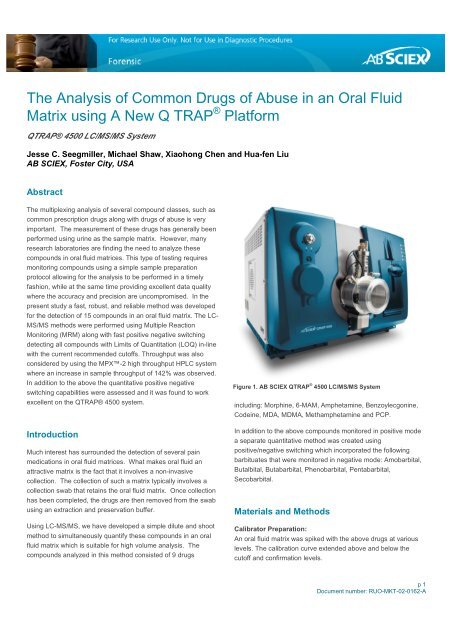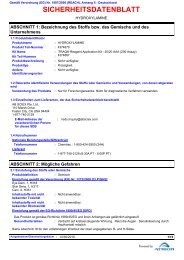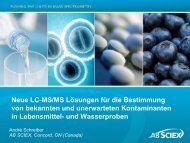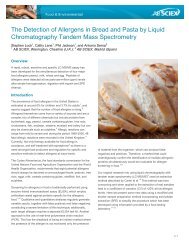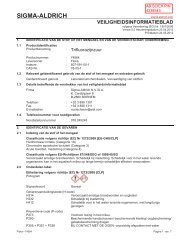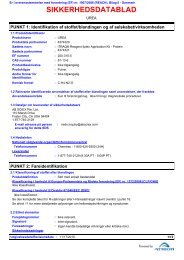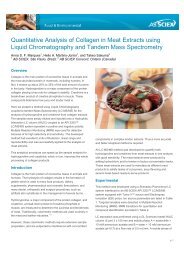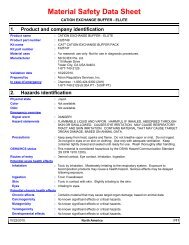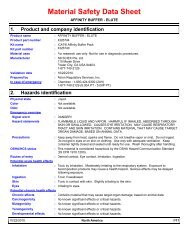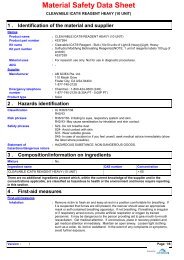RUO_MKT_02_0162_A_Forensic_4500_Drug ... - AB Sciex
RUO_MKT_02_0162_A_Forensic_4500_Drug ... - AB Sciex
RUO_MKT_02_0162_A_Forensic_4500_Drug ... - AB Sciex
You also want an ePaper? Increase the reach of your titles
YUMPU automatically turns print PDFs into web optimized ePapers that Google loves.
The Analysis of Common <strong>Drug</strong>s of Abuse in an Oral Fluid<br />
Matrix using A New Q TRAP ® Platform<br />
QTRAP® <strong>4500</strong> LC/MS/MS System<br />
Jesse C. Seegmiller, Michael Shaw, Xiaohong Chen and Hua-fen Liu<br />
<strong>AB</strong> SCIEX, Foster City, USA<br />
Abstract<br />
The multiplexing analysis of several compound classes, such as<br />
common prescription drugs along with drugs of abuse is very<br />
important. The measurement of these drugs has generally been<br />
performed using urine as the sample matrix. However, many<br />
research laboratories are finding the need to analyze these<br />
compounds in oral fluid matrices. This type of testing requires<br />
monitoring compounds using a simple sample preparation<br />
protocol allowing for the analysis to be performed in a timely<br />
fashion, while at the same time providing excellent data quality<br />
where the accuracy and precision are uncompromised. In the<br />
present study a fast, robust, and reliable method was developed<br />
for the detection of 15 compounds in an oral fluid matrix. The LC-<br />
MS/MS methods were performed using Multiple Reaction<br />
Monitoring (MRM) along with fast positive negative switching<br />
detecting all compounds with Limits of Quantitation (LOQ) in-line<br />
with the current recommended cutoffs. Throughput was also<br />
considered by using the MPX-2 high throughput HPLC system<br />
where an increase in sample throughput of 142% was observed.<br />
In addition to the above the quantitative positive negative<br />
switching capabilities were assessed and it was found to work<br />
excellent on the QTRAP® <strong>4500</strong> system.<br />
Introduction<br />
Much interest has surrounded the detection of several pain<br />
medications in oral fluid matrices. What makes oral fluid an<br />
attractive matrix is the fact that it involves a non-invasive<br />
collection. The collection of such a matrix typically involves a<br />
collection swab that retains the oral fluid matrix. Once collection<br />
has been completed, the drugs are then removed from the swab<br />
using an extraction and preservation buffer.<br />
Using LC-MS/MS, we have developed a simple dilute and shoot<br />
method to simultaneously quantify these compounds in an oral<br />
fluid matrix which is suitable for high volume analysis. The<br />
compounds analyzed in this method consisted of 9 drugs<br />
Figure 1. <strong>AB</strong> SCIEX QTRAP ® <strong>4500</strong> LC/MS/MS System<br />
including: Morphine, 6-MAM, Amphetamine, Benzoylecgonine,<br />
Codeine, MDA, MDMA, Methamphetamine and PCP.<br />
In addition to the above compounds monitored in positive mode<br />
a separate quantitative method was created using<br />
positive/negative switching which incorporated the following<br />
barbituates that were monitored in negative mode: Amobarbital,<br />
Butalbital, Butabarbital, Phenobarbital, Pentabarbital,<br />
Secobarbital.<br />
Materials and Methods<br />
Calibrator Preparation:<br />
An oral fluid matrix was spiked with the above drugs at various<br />
levels. The calibration curve extended above and below the<br />
cutoff and confirmation levels.<br />
p 1<br />
Document number: <strong>RUO</strong>-<strong>MKT</strong>-<strong>02</strong>-<strong>0162</strong>-A
Sample Preparation:<br />
The collection workflow was simulated by diluting the oral fluid<br />
matrix with an extraction buffer at the appropriate dilution factor.<br />
The samples were further diluted in an equal volume of a<br />
methanol:water diluent containing 0.1% formic acid.<br />
HPLC Conditions:<br />
Liquid chromatography was performed using the MPX-2 high<br />
throughput multiplexed HPLC system to achieve maximum<br />
throughput. Utilization of the MPX-2 system afforded analysis<br />
times of less than 5 minutes per sample. The column employed<br />
was a Phenomenex Kinetex C18 2.6u 50 x 3.0mm one where<br />
10mM Ammonium Formate in H2O was used in mobile phase A<br />
and 0.1% formic acid in methanol in mobile phase B. The<br />
injection volume was 10µL. A gradient was applied during<br />
chromatographic run and the total run time (not multiplexed) per<br />
stream was 6 minutes. The acquisition window was set to 3.5<br />
minutes per stream providing an increase in sample throughput<br />
of 142% during multiplexed analysis.<br />
Figure 3. The fast Positive Negative switching capabilities of the <strong>AB</strong><br />
SCIEX QTRAP® <strong>4500</strong> LC/MS/MS were explored in MRM mode only<br />
are displayed.<br />
Figure 4. Positive mode only MRM method.<br />
MS/MS Conditions:<br />
All samples were then analyzed using a QTRAP® <strong>4500</strong><br />
instrument operating in electrospray ionization mode and utilizing<br />
MRM acquisition. In addition to the above a quantitative positive<br />
negative switching method was found to also be viable.<br />
Results<br />
Figure 2 shows the separation of all 15 drug analytes using the<br />
positive and negative MRM switching method. In Figure 5<br />
quantitative results are shown for Amphetamine for positive<br />
mode only. Figure 6, on the other hand illustrates that the<br />
quantitative capabilities are not compromised when using the<br />
fast positive negative switching capabilities of the QTRAP® <strong>4500</strong><br />
allowing the monitoring of both positively and negatively charged<br />
compounds in the same experiment.<br />
Figure 5. Quantitative example of Amphetamine in an oral fluid<br />
matrice while using MRM and in positive mode only.<br />
Figure 2. Chromatogram of all 15 Analytes using the positive and<br />
negative MRM switching method.<br />
p 2<br />
Document number: <strong>RUO</strong>-<strong>MKT</strong>-<strong>02</strong>-<strong>0162</strong>-A
Figure 6. Quantitative example of Amphetamine in an oral fluid<br />
matrix while switching between positive and negative MRM mode.<br />
Table 1 Limits of quantitation attained in this effort.<br />
*Note that the lower sensitivity level for the barbituates was not<br />
assessed below 31.3 ng/mL<br />
Figure 7. Quantitative example of Amobarbital (negative mode) in an<br />
oral fluid matrix while switching between positive and negative MRM<br />
mode.<br />
Conclusions<br />
A simple and robust method, for the detection of 16 drugs in an<br />
oral fluid matrix was developed on the <strong>AB</strong> SCIEX QTRAP® <strong>4500</strong><br />
LC/MS/MS system. This method utilized a simple protein<br />
precipitation procedure followed by a dilution step to analyze all<br />
of the analytes. When performing quantitation from the positive<br />
and negative switching mode, the linearity and precision<br />
observed were excellent in comparison to performing positive<br />
mode only.<br />
This contribution solidifies the quantitative capabilities of the <strong>AB</strong><br />
SCIEX QTRAP® <strong>4500</strong> LC/MS/MS system where the fast<br />
electronics allow for quantitation in both positive and negative<br />
mode without compromising data quality.<br />
For Research Use Only. Not for use in diagnostic procedures.<br />
© 2012 <strong>AB</strong> SCIEX. The trademarks mentioned herein are the property of <strong>AB</strong> <strong>Sciex</strong> Pte. Ltd. or their respective owners. <strong>AB</strong> SCIEX is being used under license.<br />
Publication number: 6680112-01, Document number: <strong>RUO</strong>-<strong>MKT</strong>-<strong>02</strong>-<strong>0162</strong>-A<br />
p 3<br />
Document number: <strong>RUO</strong>-<strong>MKT</strong>-<strong>02</strong>-<strong>0162</strong>-A


